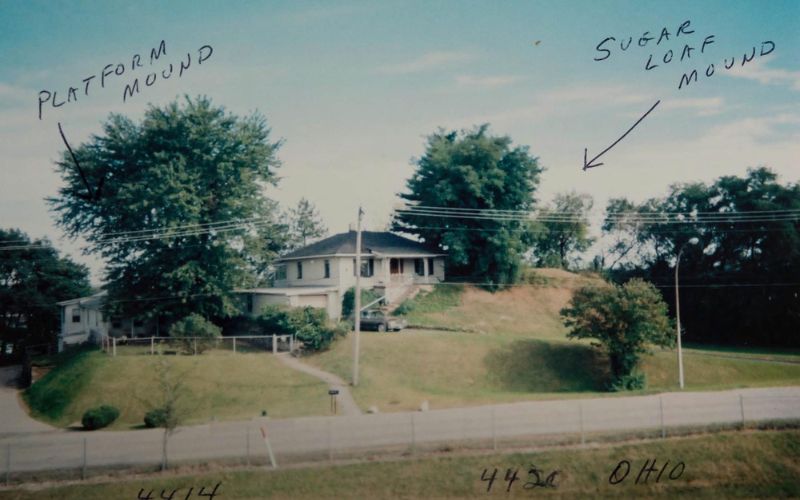
- Details
- By Kaili Berg
Sugarloaf Mound, the last remaining intact Mississippian mound is one step closer to returning to the Osage Nation.
Once part of “Mound City,” a network of over 100 earthen structures constructed by Native Americans between 800 and 1450 AD, Sugarloaf Mound is the sole surviving structure to a civilization nearly erased by colonization and urban development.
The Mississippian culture, responsible for building Sugarloaf Mound and others, was one of the most advanced pre-Columbian civilizations in North America. At its height, it included Cahokia, a massive urban center just across the Mississippi River in present-day Illinois.
Cahokia, known for its towering Monk Mound, still the largest structure in the Americas, was home to an estimated 20,000 people during its peak around 1100 AD.
Sugarloaf and Big Mound were among the most prominent structures in what is now St. Louis. These signal mounds were positioned along the Mississippi River, allowing communication with Cahokia via smoke signals.
The mounds of St. Louis stood as landmarks when the city was founded in 1764, even drawing visits from European royalty. However, settlers soon repurposed the structures, demolishing them to make way for roads, railroads, and the 1904 World’s Fair.
According to AP News, bones from Big Mound were reportedly discarded into the Mississippi River as the structure was dismantled. By the early 20th century, only Sugarloaf Mound remained.
In 2009, the Osage Nation purchased a portion of Sugarloaf Mound and began stabilizing the site. A pivotal moment came recently when 86-year-old Joan Heckenberg, who has lived on the mound for 81 years, agreed to sell her property to the Osage Nation.
Once Heckenberg moves or passes away, this part of the mound will officially return to the tribe. However, a house owned by Kappa Psi, a pharmaceutical fraternity, remains on the mound, and the fraternity has yet to commit to selling the property, AP News reported.
Efforts to rematriate Sugarloaf Mound gained momentum with the 2023 Counterpublic triennial, a public art exhibition that turned the site into a symbol of Indigneous homecoming. Public programming led by the artist collective New Red Order, curator Risa Puleo, and the Osage Nation brought visibility to the sacred mound and its importance.
The city of St. Louis has also taken steps to recognize the mounds’ significance. Alderman Cara Spencer announced plans for a resolution in January 2024 to formally acknowledge Osage sovereignty over the site.
Long-term plans include developing a cultural and interpretive center at Sugarloaf Mound, which overlooks the Mississippi River a few miles south of downtown.
For the Osage Nation, reclaiming Sugarloaf Mound is more than preserving a sacred site, it is a step toward sovereignty and the restoration of their heritage.
“To be able to at least salvage one mound in St. Louis, on the west side of the Mississippi River — it means a lot to us, to regain our heritage,” Andrea Hunter, director of the Osage Nation Historic Preservation Office, told AP News.
More Stories Like This
50 Years of Self-Determination: How a Landmark Act Empowered Tribal Sovereignty and Transformed Federal-Tribal RelationsLancaster County to Recognize Conestoga-Susquehannock Tribe on Massacre Anniversary
How the Gaming Economy Helps Tribes Navigate Shifting Policies
Prairie Band Potawatomi Nation Fires Executives After ICE-Related Contract Sparks Outcry
Tlingit Haida Tribal Business Corporation Clarifies Federal Contracting Work
Help us defend tribal sovereignty.
At Native News Online, our mission is rooted in telling the stories that strengthen sovereignty and uplift Indigenous voices — not just at year’s end, but every single day.
Because of your generosity last year, we were able to keep our reporters on the ground in tribal communities, at national gatherings and in the halls of Congress — covering the issues that matter most to Indian Country: sovereignty, culture, education, health and economic opportunity.
That support sustained us through a tough year in 2025. Now, as we look to the year ahead, we need your help right now to ensure warrior journalism remains strong — reporting that defends tribal sovereignty, amplifies Native truth, and holds power accountable.
 The stakes couldn't be higher. Your support keeps Native voices heard, Native stories told and Native sovereignty defended.
The stakes couldn't be higher. Your support keeps Native voices heard, Native stories told and Native sovereignty defended.
Stand with Warrior Journalism today.
Levi Rickert (Potawatomi), Editor & Publisher


